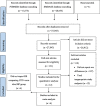The impact of hypertension on chronic kidney disease and end-stage renal disease is greater in men than women: a systematic review and meta-analysis
- PMID: 33238919
- PMCID: PMC7687699
- DOI: 10.1186/s12882-020-02151-7
The impact of hypertension on chronic kidney disease and end-stage renal disease is greater in men than women: a systematic review and meta-analysis
Erratum in
-
Correction to: The impact of hypertension on chronic kidney disease and end-stage renal disease is greater in men than women: a systematic review and meta-analysis.BMC Nephrol. 2020 Dec 21;21(1):545. doi: 10.1186/s12882-020-02199-5. BMC Nephrol. 2020. PMID: 33349232 Free PMC article. No abstract available.
Abstract
Background: Hypertension (HTN) is an established risk factor for chronic kidney disease (CKD) and end-stage renal disease (ESRD). Whether sex differences in the effect of HTN on CKD and ESRD incidence exist remains unclear. This systematic review and meta-analysis was conducted to evaluate the relative impact of HTN on CKD and ESRD risk in women compared with men.
Methods: We systematically searched Embase and PubMed for cohort studies until 24 July 2020. Studies were selected if they reported a sex-specific association between systolic blood pressure (SBP) and CKD or ESRD. Random effects meta-analyses with inverse variance weighting were used to pool sex-specific relative risks (RRs) and the women-to-men ratio of RRs (the RRR) for incident CKD and ESRD.
Results: Data from six cohorts, including 2,382,712 individuals and 6856 incident CKD events, and 833 ESRD events, were included in the meta-analysis. The RR for incident CKD or ESRD associated with HTN (SBP ≥140 mmHg) versus ideal BP (SBP < 120 mmHg) was 1.56 (95% CI, 1.39-1.75) in women and 2.06 (95% CI, 1.64-2.60) in men. The RR for incident CKD or ESRD was 23% lower in women than in men RRR 0.77 [95% CI, 0.63-0.95] with no significant heterogeneity between studies (p-value for Q test = 0.507, I2 = 17.7%).
Conclusion: HTN confers about a fifth lower excess risk of incident CKD or ESRD in women than men. Sex differences in onset, duration, and severity of some risk factors, such as albuminuria, diabetes, cardiovascular disease, obesity, and socioeconomic status, may explain part of the excess risk in men. Another explanation could be that women might be under-diagnosed and less likely to initiate dialysis. Future studies are needed to demonstrate the mechanisms responsible for the observed sex difference.
Conflict of interest statement
M. Woodward is supported by a National Health and Medical Research Council fellowship (APP1080206) and Program Grant (APP1149987) and does consultancy for Amgen and Kyowa Hakko Kirin outside the submitted work.
Figures




Similar articles
-
Age and Outcomes Associated with BP in Patients with Incident CKD.Clin J Am Soc Nephrol. 2016 May 6;11(5):821-831. doi: 10.2215/CJN.08660815. Epub 2016 Apr 21. Clin J Am Soc Nephrol. 2016. PMID: 27103623 Free PMC article.
-
Food Insecurity, CKD, and Subsequent ESRD in US Adults.Am J Kidney Dis. 2017 Jul;70(1):38-47. doi: 10.1053/j.ajkd.2016.10.035. Epub 2017 Feb 16. Am J Kidney Dis. 2017. PMID: 28215947 Free PMC article.
-
Female Reproductive Factors, Exogenous Hormone use, and Incident Chronic Kidney Disease and end-stage Renal Disease.J Clin Endocrinol Metab. 2025 Mar 17;110(4):e970-e979. doi: 10.1210/clinem/dgae374. J Clin Endocrinol Metab. 2025. PMID: 38829052
-
Pulmonary Hypertension, Mortality, and Cardiovascular Disease in CKD and ESRD Patients: A Systematic Review and Meta-analysis.Am J Kidney Dis. 2018 Jul;72(1):75-83. doi: 10.1053/j.ajkd.2017.11.018. Epub 2018 Feb 9. Am J Kidney Dis. 2018. PMID: 29429751
-
Dietary Approaches to Stop Hypertension and risk of chronic kidney disease: A systematic review and meta-analysis of observational studies.Clin Nutr. 2020 Jul;39(7):2035-2044. doi: 10.1016/j.clnu.2019.10.004. Epub 2019 Oct 15. Clin Nutr. 2020. PMID: 31669002
Cited by
-
Prevalence and assessment of risk factors of chronic kidney disease in the ASIR region of Saudi Arabia.Ann Med Surg (Lond). 2024 Jan 26;86(7):3909-3916. doi: 10.1097/MS9.0000000000001755. eCollection 2024 Jul. Ann Med Surg (Lond). 2024. PMID: 38989199 Free PMC article.
-
Metabolomic and Physiological Effects of a Cardiorenal Protective Diet Intervention in African American Adults with Chronic Kidney Disease.Metabolites. 2024 May 25;14(6):300. doi: 10.3390/metabo14060300. Metabolites. 2024. PMID: 38921435 Free PMC article.
-
Real-World Multicenter Registry to Determine Management and Quality of Care of Patients with Type 2 Diabetes, Hypertension, Heart Failure and/or Chronic Kidney Diseases in China (iCaReMe China).Adv Ther. 2025 Mar;42(3):1600-1609. doi: 10.1007/s12325-025-03114-w. Epub 2025 Feb 10. Adv Ther. 2025. PMID: 39928243
-
A Genome-Wide Association Study for Hypertensive Kidney Disease in Korean Men.Genes (Basel). 2021 May 17;12(5):751. doi: 10.3390/genes12050751. Genes (Basel). 2021. PMID: 34067580 Free PMC article.
-
The national trend of the burden of Chronic Kidney Disease (CKD) in Iran from 1990 to 2019.J Diabetes Metab Disord. 2023 Sep 26;22(2):1657-1671. doi: 10.1007/s40200-023-01298-y. eCollection 2023 Dec. J Diabetes Metab Disord. 2023. PMID: 37975103 Free PMC article.
References
-
- GBD 2017 DALYs and HALE Collaborators Global, regional, and national disability-adjusted life-years (DALYs) for 359 diseases and injuries and healthy life expectancy (HALE) for 195 countries and territories, 1990–2017: a systematic analysis for the global burden of disease study 2017. Lancet. 2018;392(10159):1859–1922. doi: 10.1016/S0140-6736(18)32335-3. - DOI - PMC - PubMed
Publication types
MeSH terms
LinkOut - more resources
Full Text Sources
Medical

